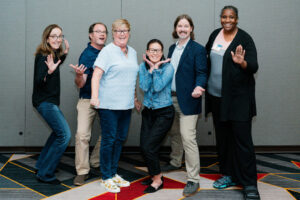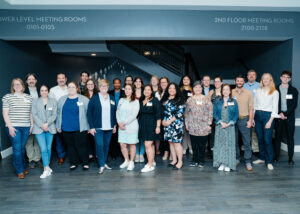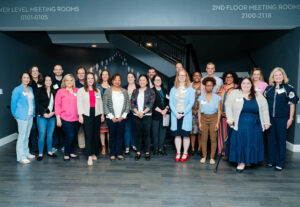by Jeff Muller, Founder and Chief Strategist, Crossroads Insights. LLC




On May 6 and 7, more than 85 mid-level fundraising professionals from across the country and representing over 40 organizations gathered at the College Park Marriott in Hyattsville, Maryland for DMFA’s Second Annual Mid-Level Giving Benchmarking Summit. For two action-packed days, participants explored industry trends, shared analysis and insights, and spent quality time learning from each other. Conversations were held during a mix of general and concurrent sessions, as well as during meals, breaks, and an off-site dinner on the first night. Throughout, the energy was high as were the reviews of the event. See photos of the event here.
This year’s big takeaway
The big headline is that this year’s benchmarking survey demonstrated that participation in the DMFA Mid-Level Giving Benchmarking effort is paying off, as engaged mid-level programs “outperform” the broader nonprofit sector, besting broader retention levels as tracked by the Fundraising Effectiveness Project (FEP) by nearly 15 percent. Notably, the most recent FEP report shows an average retention of donors in the $500+ range of 61.7 percent, whereas the DMFA MLG benchmarking group has an average multi-year retention of 76 percent. The sharing and support that is occurring in the MLG community is equipping participants to outperform their peers who are not engaged in this powerful capacity-building opportunity.
The Summit is a rich learning opportunity
Every conference session featured participants sharing effective strategies and learning from one another. For example, during a discussion about best practices in surveying donors, participants from the American Civil Liberties Union shared how they are using Insight Panels to identify donor issue preferences, a concept that others want to pursue.
While meaningful exchanges happened throughout, two of the highest-profile opportunities came on day two. First, Ishmam Rahman of the International Rescue Committee (IRC) presented a case study at the general session featuring their work to create a branded mid-level program, which has resulted in growth of an astounding 104% over two fiscal years. Not only did Ishmam identify the work of peers from the MLG group as helpful models they borrowed from in designing their program, but likewise, a number of this year’s participants identified several aspects of IRC’s program that they want to replicate at their institutions. At the end of that day, Valerie Vierengel from the International Fund for Animal Welfare—who is also a MLG Committee member—led a session in which she showcased some outstanding creative samples that had been shared by summit participants. Notes were taken and many participants walked away with some exciting new ideas to try in future fundraising packages. While anyone can peruse others’ creative samples for ideas, there is something powerful about being shown a curated set of materials with commentary, then being able to discuss with a group of like-minded peers.
Clearly, the “lift all ships” ethos of the MLG cohort is paying real dividends to participating organizations. In fact, there were many such stories shared throughout the summit. Here are just a few others. In one concurrent session, participants from the American Cancer Society spoke of how they leveraged a Doctors Without Borders idea from the previous year to create a match campaign that helped them reach their annual revenue target. Similarly, several groups discussed how they have effectively deployed an approach that Guide Dogs for the Blind had previously shared about how to get a group of donors to step up to create a challenge grant. Finally, there were a number of organizations that have successfully adapted the International Fund for Animal Welfare’s retention strategy aimed at building strong relationships with donors through targeted communications during the first 90 days after their first gift.
In addition to robust peer learning opportunities, representatives from the summit’s sponsors shared valuable ideas during the general sessions and in the exhibition hall during breaks. There were many participants taking notes as the following companies offered their insights: Allegiance Group + Pursuant, Data Axle, Faircom New York, Merkle, Production Solutions, RKD Group, Synergy Direct Marketing Solutions, True Sense, and Wiland. While they were unable to attend, The Lukens Company and McVicker & Higginbotham are also valued sponsors.
In their own words: What makes the Summit special
Throughout the summit, participants were clear that this event is unique—and essential for their mid-level program’s success. Here are three key themes that emerged:
First, the MLG Benchmarking Summit is the only event of its kind. As Ishmam Rahman of the International Rescue Committee said, “There’s no other conference that really focuses on the mid-level giving audience. This is the only one I’ve attended where all attendees specialize in the same thing, so 100% of it is usable and relatable.”
Second, the summit is focused on encouraging dialogue and group problem solving rather than just providing a platform for presentations. This was identified by Alec Bandzes of the Wildlife Conservation Society, who noted, “We’re all at different stages in our career and we’re all coming up with the solutions together, and that is so valuable.” It’s rare to find a setting in which people with different levels of experience and responsibility can all engage together to find solutions. Moreover, the nature of the breakout groups changes throughout each day, providing additional dimensions and perspectives to the conversations. In one session, participants are grouped by their industry vertical, providing the opportunity to explore how mission and topic affect fundraising. In the next, participants are grouped by the size of their mid-level programs, providing the opportunity to explore themes related to program size, staffing, and capacity. A final cohort is arranged around how long an organization has been engaged with the DMFA Mid-Level Giving Benchmarking effort, which provides additional variations while creating a structure in which participants can learn and grow together. As many academics have noted, embracing diversity strengthens our organizations by providing multiple perspectives. This is especially important for solving complex problems.
Finally, the summit is continuing to evolve and grow, bringing additional organizations and perspectives to the table each year. Catherine Carithers of The Nature Conservancy, who has been a participant in the DMFA Mid-Level Giving Benchmarking effort for the last six of its ten years in existence and who attended earlier meetings, had this to say: “I’m learning so much from folks I didn’t have the opportunity to connect with in the past, like Planned Parenthood, Doctors Without Borders, and other organizations that have well-respected mid-level programs. It’s so exciting to be able to talk to these folks and take new ideas back to what I’m doing.”
The biggest challenges and questions participants are wrestling with
Even with all the solutions provided throughout the summit, there are an equal number of challenges and questions participating organizations are wrestling with. Heading into this year’s summit, more than one quarter of MLG Benchmarking Summit participants identified retention as their program’s greatest challenge, demonstrating that there is still room to improve in these already high-performing programs. Interestingly, those organizations that work in international relief were not immediately concerned with retention because the global context—which includes ongoing wars—has turned their attention to how best to manage the influx of donors who have responded to these tragic events.
Other areas of challenge affecting 10 percent or more of participants include the impact of the economy on program performance, issues of getting sufficient staffing and resources to meet program objectives, developing effective audience strategies, and how best to structure the mid-level acquisition program.
Additional, and often nuanced, challenges and questions were identified during the summit. Here are three that emerged from the various discussions. First, the question was raised as to what the best timing is for DAF solicitations so as not to cannibalize direct giving, especially at year end. Second, several participants were exploring what is the most effective way to build a lapsed/reengagement campaign. Third, there remain strategic questions as to how best to ensure donors don’t go without communication when handing them off to major gift programs for qualification.
Looking forward to next year’s Summit
As the proverbial page turns, the DMFA Mid-Level Giving Committee, summit attendees, and sponsors are already looking forward to the Third Annual Mid-Level Giving Benchmarking Summit, which will take place on April 29-30, 2025, back at the College Park Marriott in Hyattsville, Maryland. Make plans now to join this special event, which has quickly become the annual highlight for mid-level fundraisers who are leading the most successful programs in the country.

